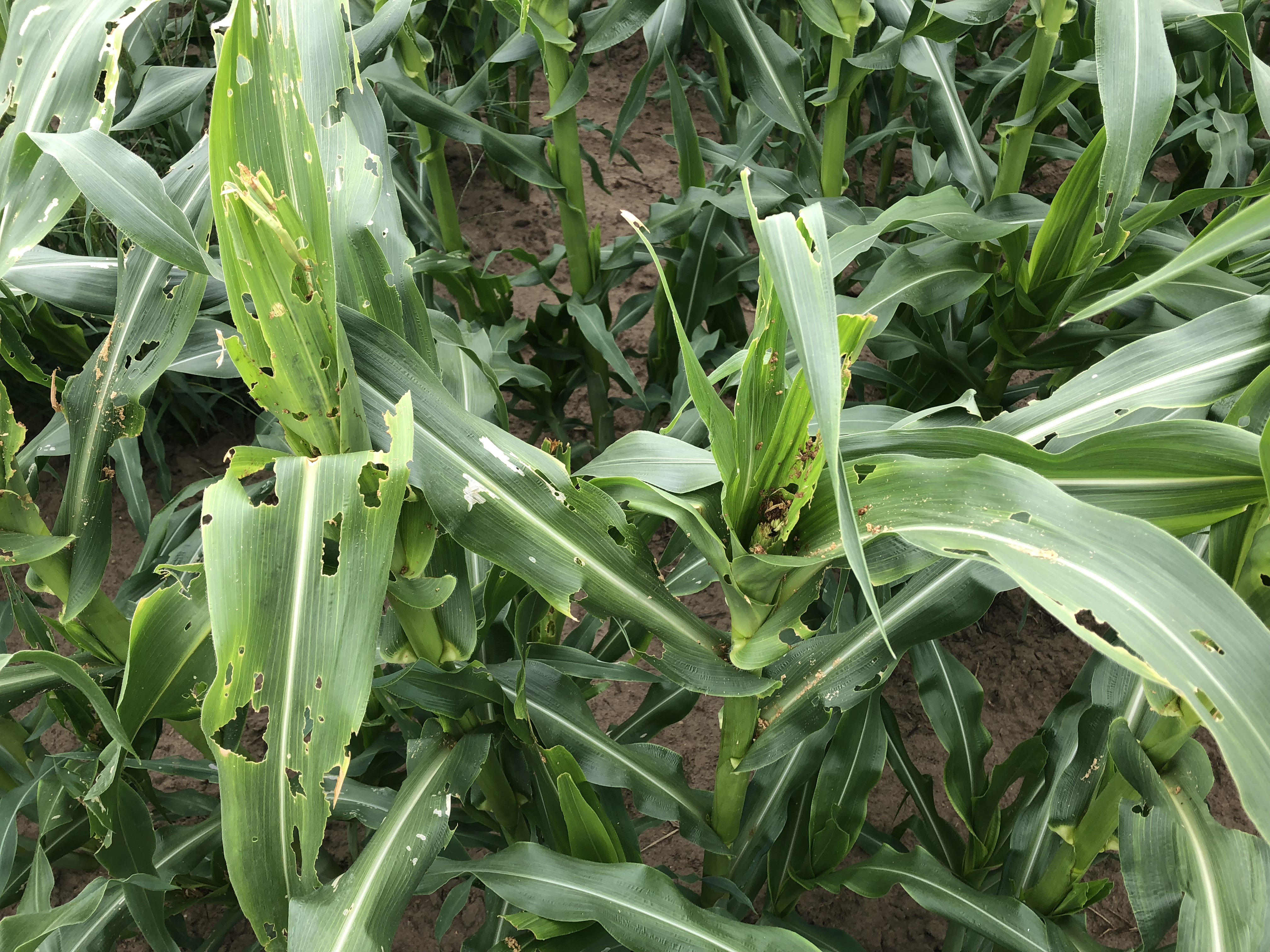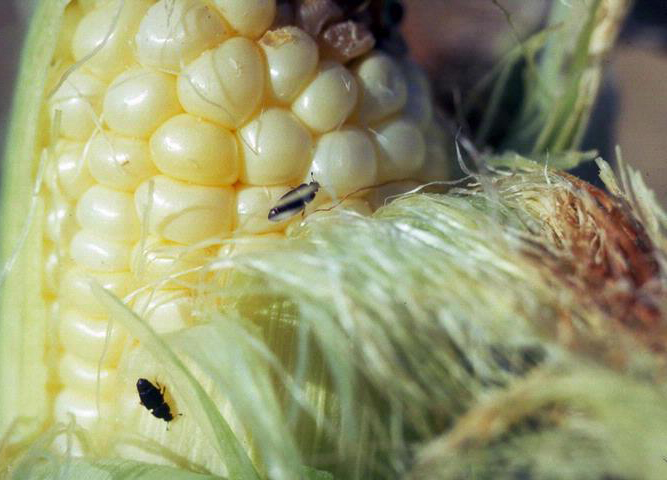Southeast Michigan vegetable update – Aug. 1, 2018
Finally, some rain! Expect more disease and continued insect pressure.

Weather
Steady light rains and pockets of more severe weather moved across much of our region last night, July 31. Some parts of our region (from Adrian to Jackson up to East Lansing) were under drought conditions, so the rain is much needed. Now that we have more moisture, stay on top of fungicide and copper applications.
I got some reports of hail damage in Wayne and Washtenaw counties last week. In the event of hail, get into the field with a fungicide and copper spray to help prevent fungi and bacteria from getting into the plant’s wounds as soon as possible.
The table below presents rainfall (in inches) for the Michigan State University Enviroweather stations in southeast Michigan, as well as growing degree-days (GDD) calculated using the Baskerville-Emin Method. Degree-day average for Commerce and Hudson is over five years, while Deerfield is over two years. Rainfall is in inches, with parenthesis indicating precipitation accumulations since last week’s report.
|
Rainfall and GDD totals as of Aug. 1 | ||||
|---|---|---|---|---|
|
Station |
GDD (base 42) |
GDD (base 50) |
5-year GDD average (base 50) |
Rainfall since April 1 |
|
Commerce |
2,499 |
1,707 |
1,526.4 |
13.9 (+0.99) |
|
Deerfield |
2,703 |
1,882 |
1,858.5 |
11.47 (+1.19) |
|
Hudson |
2,570 |
1,762 |
1,650.3 |
14.17 (+1.16) |
Crops
Cabbage harvest is picking up on more farms, transplanting of fall cabbage continues. The main caterpillar pest out right now is imported cabbage worm; cabbage aphid levels are high on some organic farms.
In carrots, fungal foliar diseases are present at levels that warrant treatment.
In cucumbers, downy mildew reports continue to roll in from the southwest part of the state, and with the recent moisture, I suspect it will be in the eastside soon if it isn’t already. Stay on top of spray programs.
Muskmelons are sizing up and large-scale harvest will begin soon. I’ve gotten some questions about yellowed edges of older leaves. This is typically nothing to worry about, it is usually the result of guttation (droplets that naturally are exuded at leaf edges) and time, as substances found in the droplets accumulate on the leaf edge and cause plant damage, which then causes the edge of the leaf to yellow. It is likely we will get our first report of downy mildew on the eastside in the week, so keep on top of preventative sprays.
Bell pepper harvest is ongoing. The Deerfield Enviroweather station degree-day model for European corn borer is predicting the current generation will stop flying Aug. 4.
In pumpkins, keep on top of powdery mildew preventative sprays. There are a fair number of squash bug eggs in fields (Photo 1), so keep an eye out for the gray nymphs in a week’s time. When you’re seeing these nymphs, it is time to treat.
Sweet corn harvest continues. Corn earworm catches continue to be minimal (three moths per week in Monroe, zero moths per week in Lenawee). Western bean cutworm populations are variable. In some areas we are still in peak flight, while in other areas trap catches suggest moth flight is slowing down. In fields I’ve scouted in the last week, I have found egg masses, but I really had to look for them, and in the end the field was below the 1 percent fresh market threshold.
I did see a field with some fall armyworm feeding in pre-tassel corn (Photo 2). These caterpillars can end up in the ear, but the treatment threshold is around 15 percent. Fall armyworm lay their eggs in pre-tassel corn initially, so you can scout for fall armyworm while scouting for western bean cutworm eggs.

Photo 2. Fall armyworm feeding is typically clustered in a field. Look for holes in the top portion of the plant and a tassel full of frass. Photo by Marissa Schuh, MSU Extension.
I’ve also heard reports of extreme bird damage. Any vertebrate pest is hard to manage, as they learn quickly and you are limited in what measures you can take. For birds, a key aspect of control is having any noise or visual scare in the field before they find the corn. Noise deterrents, visual deterrents and chemical deterrents are all available. Cornell University has a nice write-up of the cost and time considerations, as well as the efficacy of different management strategies: “Bird Damage Management Options in Sweet Corn Production.”
In corn that has been damaged by birds or other worms, you often see sap beetles and their larvae in the ears (Photo 3). If you are seeing small, dark beetles or 1-2 millimeter worms that are so light they are nearly transparent, it’s likely you’re seeing sap beetles. These insects are attracted to the smell of decay, so it is unlikely the primary pest causing damage in ears where they are found.

Photo 3. Adult sap beetles feed and lay eggs in sweet corn, typically in ears that have been damaged by birds, caterpillars or weather events. Photo by Eugene E. Nelson, Bugwood.org.
Processing tomato ethereal sprays are on the horizon on many farms. No late blight has been reported in Michigan.
Contact me any time at 517-264-5309 or schuhmar@msu.edu with pest identification requests and questions. I tweet about what I’m seeing @SoutheastMIVeg.
General notes and meeting announcements
Curious about using drones in agriculture? Attend the Tri-State UAV Field Day Aug. 27 in Ohio. Contact Ricardo Costa at costasil@anr.msu.edu or 573-639-8971 for more information and registration.
Organic growers are invited to attend the Organic Management Field Day on Sept. 19 at the Kellogg Biological Station.
The Midwest Mechanical Weed Control Field Day is Sept. 26 at the PrairiErth Farm (2073 2000 Ave, Atlanta, IL 61723). See in-row cultivation tools demonstrated on vegetable crops, a trade show and grower experiences with mechanical cultivation. The field day begins at 9:30 a.m. and wraps up around 4 p.m. The event registration is $20, lunch included. Check out the Mechanical Vegetable Cultivation Facebook page for more information.
It is never too early to make accommodations to attend Great Lakes Fruit and Vegetable EXPO, Dec. 4-6 in Grand Rapids, Michigan. Hotel blocks are open and tend to go fast. The combination of grower-focused, research-backed presentations and an exhibit hall featuring a diverse set of vendors make it a can’t-miss event.



 Print
Print Email
Email

